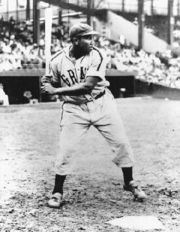
1930s-WWII
The early 1930s experienced a small surge in Latin players in Major League Baseball when the Washington Senators, an American League team, signed several. Like earlier years, however, these players were almost entirely Cuban. Several other teams followed suit, such as the Chicago Cubs, Philadelphia Athletics, Philadelphia Phillies, and Boston Red Sox. The first two Mexican players to play in the Majors, Baldomero Almada (1933) and José Gómez (1935), were signed during this period, though their careers only spanned a handful of games (6).
In 1934, Miguel Angel Gonzalez, a Cuban who had played in the Majors for 17 years, was hired as a coach for the National League St. Louis Cardinals (7). Four years later, he became interim manager for the team, officially becoming the first Latino manager in Major League history. Gonzalez was also instrumental in influencing the development of Cuban baseball, as he held significant influence (including managerial positions) over the team from 1914 to 1960, when Cuban professional baseball ended (8). Adolfo Luque, one of the great Latino players from the previous decades, became a coach during this time as well. It is widely believed that the respect Luque commanded as a coach and the fear he imparted on much of Major League Baseball with his infamously fiery temper helped pave the way for Jackie Robinson to break the color barrier in the MLB and allow for a great influx of Latinos into the game (9).
During World War II, when many of America's young men were off fighting the war, several Major League teams looked towards Cuba to fill their rosters. Cubans, not subject to the military draft taking place in the United States, with at least five teams signing players that would end up having a significant impact on their rosters. The Washington Senators experienced the most success with Latino players during this time, nearly winning the pennant in 1945 while employing at least five Cuban players who regularly contributed to the team and also signing the first Venezuelan in Major League Baseball, Alejandro Carrasquel (10).
This time period wasn't entirely great for Latinos in Major League Baseball, however. During the 1940s, the MLB fined several of its Latino players for participating in both the Mexican League and the Major League. Some players were forced to quit Major League Baseball and were virtually outlawed from the game. As a result of this fiasco, organized baseball in the United States formed an agreement with the Cuban League in 1947 to allow minor league players and new major league players to play winter ball in Cuba (11). Some of the players banned as a result of the Mexican League incident, also banned from the Cuban League, tried to form a new league in Cuba to rival the Cuban League, called the Player's Federation, but it collapsed after one year due to a lack of support (12).
Cuban League player Josh Gibson